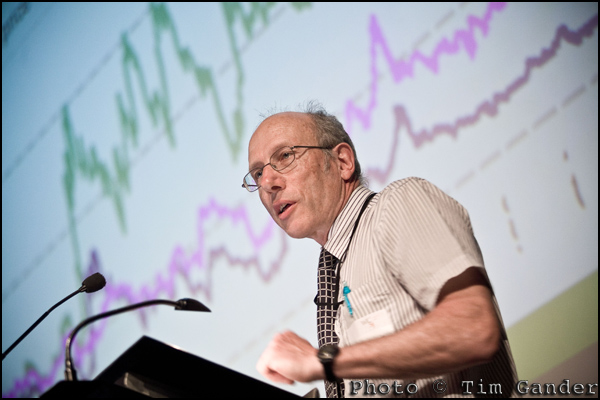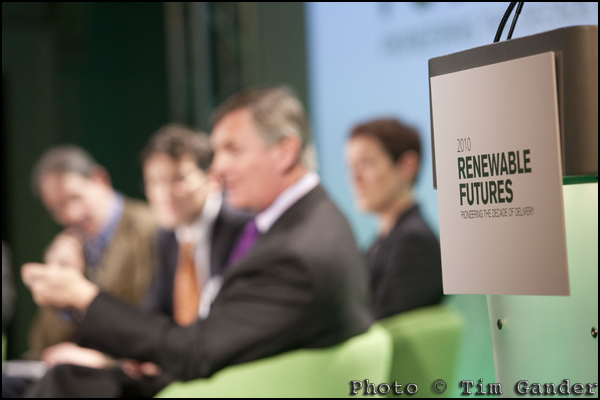Case Study: Conference Photography
Conference venues have had a rough time in recent years. Events can be expensive to run, and sometimes they’re expensive to attend, so where businesses have dared spend the money at all, they’ve often seen photography as a luxury bolt-on.
In my role as conference photographer I noticed a decline in appetite for this particular service in 2008/2009, but looking back over 2010 I’d say demand has increased again.
Getting quality photography at a conference has often been pretty low on organisers’ lists of priorities – that is until the conference is over and someone wants to “PR” the event. At which point they discover that all they have are some iPhone snaps which aren’t much use for anything at all except maybe viewing on an iPhone.
I can tell a client hasn’t given too much thought to photography prior to the event when I get the call the week before it’s due to happen to ask if I’m available and what the cost would be. They booked the venue about a year in advance. They booked the speakers, sound, lighting, video, staging, caterers, cleaners door staff etc etc. And (relatively speaking) at 5 minutes to midnight, somebody thought: “Oh! I think we might want some pictures from this event!”
Now I applaud these people for thinking so far in advance because as I said, some don’t think of it until the event is over, by which time it’s a bit too late to go back in time to shoot what should have been shot in the first place.
So if your organisation is considering a conference, which after all can reap great benefits in public relations, client relations and exchange of ideas with partners and clients, I would urge you to consider the benefits of getting coverage, and of getting that coverage done professionally.
Conferences can be very useful in that unlike most other events or times of the working year, they tend to be the one time when a significant number of staff and executives are in one place at the same time. So think about getting fresh headshots done – a small setup in a side-room or quiet corner is ideal for this.
A conference with industry-wide or even public interest, has scope for extensive PR. Pictures of key speakers talking passionately at the lectern, or as a panel of experts can add spontaneity to what might otherwise be a dull PR shot. For other PR uses it’s handy to get a relaxed portrait of key speakers at the venue, perhaps with relevant props visible in the shot.
Employing a professional (like wot I is) means not only will you get the vital shots you need, but you’ll get quick turnaround and you’ll also get the shots you never even realised you needed. Those little details that others would walk past, but which come in handy for future uses such as brochures, annual reports etc.
Of course you might find you have a keen photographer amongst your staff, but do they know how to handle the difficult lighting at these events? Balancing light on the speaker with the slide behind them isn’t always easy. They’ll also tend to miss the details I mentioned, and they often can’t turn the work around quickly. Finally, using a member of staff is all very well, but shouldn’t they be paying attention to the conference rather than the settings on their camera?
I cover conferences of all sizes, taking pictures which clients can then use for internal and external communications, press releases, websites, brochures, future presentations; the list is limited only by one’s imagination. In terms of cost, the photography has to be one of the better value ingredients of a good conference. The food can only be eaten once, while the photography can be used again and again, long after the taste of plastic ham sandwiches and greasy tea has passed.



Nice read Tim, I used to do a fair bit of conference photography in the past, it is a amazing the things I learnt from it all, some good and some bad.
Expanding on the theme a little, developing a nice collection of professional photos for later use is about the most sound idea a researcher/business owner/ PR dude or dudette can get involved in.
I have designed and viewed so many research papers, posters at conferences and annual reports etc over the years and I say with extreme bias that the ones that stand out are the ones that have obviously had good photography to draw from. At a recent conference in Brighton one poster I was reading was well written, nice design yet the team photo was taken on a phone camera, and not a very good one, I can’t begin to tell you how distracting that was while trying to absorb the info on the poster.
Conference photography is good solid “action” photography to draw from for annual reports et el which are generally pretty banal reading without the odd photo.
cheers
Thanks Ken,
Interesting what you say about pictures on posters and stands. There seems to be a particular mental block about those. A kind of “it looked ok on my computer” mentality. I think even some designers are scared to go back to the client and tell them the photos they’ve supplied are hopeless, though I know many who are on such tight deadlines and budgets that they don’t get the opportunity to improve on what’s there.
That’s where getting decent stock images from an event in the first place can really pay for itself. Plus when designers or their clients use someone like me, the don’t have to play Hunt the JPEG on different computers and old scratched DVDs lying around on office desks. They just log into the gallery I’ve set them up with and download what they need from there, when they need it.
Thanks Ken,
Attractive what you pronounce concerning films on posters and stands. There seems to be a scrupulous cerebral building block on the subject of those. A variety of “it looked ok on my computer” way of thinking.
Best Regards
Mr.Alex Talbit